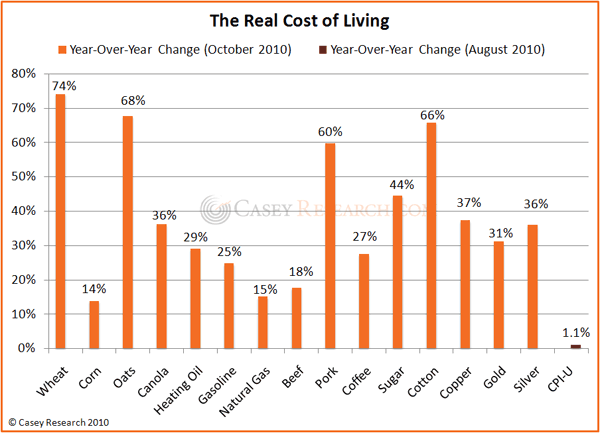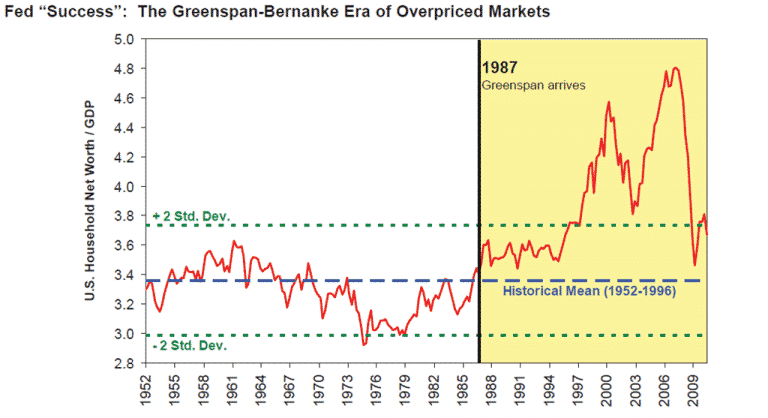Grantham: Night of The Living Fed
From From Jeremy Grantham’s latest quarterly letter:
If I were a benevolent dictator, I would strip the Fed of its obligation to worry about the economy and ask it to limit its meddling to attempting to manage inflation. Better yet, I would limit its activities to making sure that the economy had a suitable amount of liquidity to function normally. Further, I would force it to swear off manipulating asset prices through artificially low rates and asymmetric promises of help in tough times – the Greenspan/Bernanke put. It would be a better, simpler, and less dangerous world, although one much less exciting for us students of bubbles. Only by hammering away at its giant past mistakes as well as its dangerous current policy can we hope to generate enough awareness by 2014: Bernanke’s next scheduled reappointment hearing.
This paragraph and the depiction above from the newsletter demonstrate that Grantham sees the Fed at the centre of four major events in the post-bubble era: runaway commodity prices, zombie banks that don’t lend enough to customers or issue dividends to investors, the foreclosure crisis, and ‘the currency wars.’ I have written endlessly about the Fed’s machinations to pump up asset prices via an asymmetric policy which promotes the accumulation of debt. Like Grantham, I am coming to the conclusion that the Fed needs a lot less power. Even in the circumscribed role which Grantham would permit the Fed, we had to marvel at how it passed out favours to the banks via buying up dodgy collateral for loans at low rates. Moreover, on that very score, let’s not forget the secrecy with which the Fed is trying to operate. It has taken a lawsuit to the Appellate courts to get them to come to heel. Of course, the Dodd-Frank legislation passed by Congress and supported by the Obama Administration gives the Fed more not less power.
Here’s how Grantham summarizes the case against the Fed.
- Long-term data suggests that higher debt levels are not correlated with higher GDP growth rates.
- Therefore, lowering rates to encourage more debt is useless at the second derivative level.
- Lower rates, however, certainly do encourage speculation in markets and produce higher-priced and therefore less rewarding investments, which tilt markets toward the speculative end. Sustained higher prices mislead consumers and budgets alike.
- Our new Presidential Cycle data also shows no measurable economic benefits in Year 3, yet point to a striking market and speculative stock effect. This effect goes back to FDR, and is felt all around the world.
- It seems certain that the Fed is aware that low rates and moral hazard encourage higher asset prices and increased speculation, and that higher asset prices have a beneficial short-term impact on the economy, mainly through the wealth effect. It is also probable that the Fed knows that the other direct effects of monetary policy on the economy are negligible.
- It seems certain that the Fed uses this type of stimulus to help the recovery from even mild recessions, which might be healthier in the long-term for the economy to accept.
- The Fed, both now and under Greenspan, expressed no concern with the later stages of investment bubbles. This sets up a much-increased probability of bubbles forming and breaking, always dangerous events. Even as much of the rest of the world expresses concern with asset bubbles, Bernanke expresses none. (Yellen to the rescue?
- The economic stimulus of higher asset prices, mild in the case of stocks and intense in the case of houses, is in any case all given back with interest as bubbles break and even overcorrect, causing intense financial and economic pain.
- Persistently over-stimulated asset prices seduce states, municipalities, endowments, and pension funds into assuming unrealistic return assumptions, which can and have caused financial crises as asset prices revert back to replacement cost or below.
- Artificially high asset prices also encourage misallocation of resources, as epitomized in the dotcom and fiber optic cable booms of 1999, and the overbuilding of houses from 2005 through 2007.
- Housing is much more dangerous to mess with than stocks, as houses are more broadly owned, more easily borrowed against, and seen as a more stable asset. Consequently, the wealth effect is greater.
- More importantly, house prices, unlike equities, have a direct effect on the economy by stimulating overbuilding. By 2007, overbuilding employed about 1 million additional, mostly lightly skilled, people, not counting the associated stimulus from housing related purchases.
- This increment of employment probably masked a structural increase in unemployment between 2002 and 2007, which was likely caused by global trade developments. With the housing bust, construction fell below normal and revealed this large increment in structural unemployment. Since these particular jobs may not come back, even in 10 years, this problem may call for retraining or special incentives.
- Housing busts also help to partly freeze the movement of labor; people are reluctant to move if they have negative house equity. The lesson here is: Do not mess with housing!
- Lower rates always transfer wealth from retirees (debt owners) to corporations (debt for expansion, theoretically) and the financial industry. This time, there are more retirees and the pain is greater, and corporations are notably avoiding capital spending and, therefore, the benefits are reduced. It is likely that there is no net benefit to artificially low rates.
- Quantitative easing is likely to turn out to be an even more desperate maneuver than the typical low rate policy. Importantly, by increasing inflation fears, this easing has sent the dollar down and commodity prices up.
- Weakening the dollar and being seen as certain to do that increases the chances of currency friction, which could spiral out of control.
- In almost every respect, adhering to a policy of low rates, employing quantitative easing, deliberately stimulating asset prices, ignoring the consequences of bubbles breaking, and displaying a complete refusal to learn from experience has left Fed policy as a large net negative to the production of a healthy, stable economy with strong employment.
If this list sounds familiar to Credit Writedowns’ readers, it’s because it’s very nearly what I wrote in 2008 about the Fed in The US Economy 2008. So, clearly the Fed is at it yet again, blowing bubbles, misallocating resources, and creating the seeds of another massive bust down the line. Why is this considered ‘necessary’ by many economists just because this last bust has been that much greater? Are they not worried about the misallocated resources and the bubbles and the eventual bust? Look at this chart from Casey Research:
This is the direct result of the Fed’s policies. While I don’t believe this inflation in commodity prices will feed through on a secular basis quite yet, the increase in agricultural commodity prices is still making for some serious food inflation in the US that will hit lower-income people especially hard.
For his part, Grantham goes into much greater detail as to what the effects will be on the economy – taking each of the 18 bullets above in detail. It is very recommended reading. You will need to register to get it. Position your investments accordingly.
Source: Night of the Living Fed – Jeremy Grantham, GMO



Edward,
Do you realistically see the Fed losing some of its power. The fact that the Federal Reserve got more power, not less, after the whole mess they created is rather chilling. And it makes me wonder exactly WHAT will need to transpire to move/force the Fed away from asset price inflation and blowing bubbles.
Not to many years ago, I had high regard for the Federal Reserve and considered it one of the better institutions of the US government. But now I find the Federal Reserve almost reprehensible, as its basically nothing more than an implement to be used for the benefit of those “plugged in” to the system. I also find it amazing that the Federal Reserve either doesn’t see or simply doesn’t care about the lost income of retirees, pension funds, etc.. due to the zero interest rate policy. Finally, the Fed seems to have zero interest in the hardships that commodity/asset price inflation has on lower income households.
The US is still a consumer based economy. I fail to see how forcing the cost of living for necessities will stimulate a consumer based economy. The huge spike in oil prices in 2008 certainly played a role in the causing the last recession. Yet the Fed seems completely blind to it.
Anyways, just ranting. The more I read about the Federal Reserve, the more nauseating it seems to become!
What will it take for the Fed to relent? A collapse of the economic system. This is what we nearly got but they are still at it – with more power to boot. Nothing will bring a correction course except complete Great Depression-or Weimar-style collapse. So we should sit tight and hope for the best outcome from the Fed’s meddling.
What do you consider the “best outcome?”
The best outcome would be a multi year recovery with 2 percent to 3 percent inflation and a moderate rise in asset prices